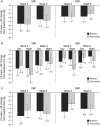Effect of Febuxostat on Ambulatory Blood Pressure in Subjects With Hyperuricemia and Hypertension: A Phase 2 Randomized Placebo-Controlled Study
- PMID: 29102979
- PMCID: PMC5721765
- DOI: 10.1161/JAHA.117.006683
Effect of Febuxostat on Ambulatory Blood Pressure in Subjects With Hyperuricemia and Hypertension: A Phase 2 Randomized Placebo-Controlled Study
Abstract
Background: Hyperuricemia is associated with hypertension, with elevated serum uric acid levels postulated to have a causal role in the development of hypertension. Consequently, serum uric acid reduction may help lower blood pressure (BP). A Phase 2, double-blind, placebo-controlled trial was conducted to assess the potential BP-lowering effects of the xanthine oxidase inhibitor febuxostat in subjects with hypertension and hyperuricemia (serum uric acid ≥0.42 mmol/L [≥7.0 mg/dL]).
Methods and results: Subjects (n=121) were randomized 1:1 to febuxostat 80 mg once daily or to placebo. The primary end point was change from baseline to Week 6 in 24-hour mean ambulatory systolic BP (SBP). Additional end points included the following: change from baseline to Week 3 in 24-hour mean SBP and changes from baseline to Weeks 3 and 6 in 24-hour mean ambulatory diastolic BP, serum uric acid, mean daytime and nighttime ambulatory SBP/diastolic BP, and clinic SBP/diastolic BP. For the overall study population, there were no significant differences between febuxostat and placebo for changes from baseline to Weeks 3 or 6 in ambulatory, daytime or nighttime, or clinic SBP or diastolic BP. However, in a preplanned subgroup analysis, there was a significant decrease in SBP from baseline to Week 6 in subjects with normal renal function (estimated glomerular filtration rate ≥90 mL/min) treated with febuxostat versus placebo; least squares mean difference, -6.7; 95% confidence interval -13.3 to -0.0; P=0.049.
Conclusions: This study suggests that febuxostat may lower BP in hyperuricemic patients with hypertension and normal renal function; further studies should be conducted to confirm this finding.
Clinical trial registration: URL: http://www.clinicaltrials.gov. Unique identifier: NCT01496469.
Keywords: ambulatory blood pressure monitoring; febuxostat; hypertension; hyperuricemia; serum urate; uric acid.
© 2017 The Authors and Takeda Pharmaceuticals. Published on behalf of the American Heart Association, Inc., by Wiley.
Figures



References
-
- Takeda Pharmaceuticals . Febuxostat prescribing information 2009. Available at: http://general.takedapharm.com/content/file.aspx?filetypecode=ULORICPI&c.... Accessed May 8, 2017.
-
- Hosoya T, Ono I. A repeated oral administration study of febuxostat (TMX‐67), a non‐purine‐selective inhibitor of xanthine oxidase, in patients with impaired renal function in Japan: pharmacokinetic and pharmacodynamic study. J Clin Rheumatol. 2011;17(4 suppl 2):S27–S34. - PubMed
-
- Sánchez‐Lozada LG, Lanaspa MA, Cristóbal‐García M, García‐Arroyo F, Soto V, Cruz‐Robles D, Nakagawa T, Yu MA, Kang D‐H, Johnson RJ. Uric acid‐induced endothelial dysfunction is associated with mitochondrial alterations and decreased intracellular ATP concentrations. Nephron Exp Nephrol. 2012;121:e71–e78. - PMC - PubMed
-
- Ho W‐J, Tsai W‐P, Yu K‐H, Tsay P‐K, Wang C‐L, Hsu T‐S, Kuo C‐T. Association between endothelial dysfunction and hyperuricaemia. Rheumatology. 2010;49:1929–1934. - PubMed
-
- Morris ST, Jardine AG. The vascular endothelium in chronic renal failure. J Nephrol. 2000;13:96–105. - PubMed
Publication types
MeSH terms
Substances
Associated data
LinkOut - more resources
Full Text Sources
Other Literature Sources
Medical

